PARISH OF DRUMGATH
by Peter and Aidan Sands
Drumgath is one of the smallest parishes in the
diocese of Dromore. It comprises thirteen townlands and includes the
small market town of Rathfriland which dominates the surrounding drumlin
countryside. The parish was established by the Synod of Kells in 1152
when parishes in Ireland were first created. There are three Roman
Catholic churches in the parish: Saint Colman's, Barnmeen, Saint Mary's,
Rathfriland and Saint Patrick's, Drumgath. Around these three Catholic
community identities have grown up.
Prior to the Synod of Kells, the district was
ministered to by monks. It is likely that there was a monastery around
about the site of the old Drumgath Cemetery - the finding of a ninth or
tenth-century bell by a local woman in 1764 would substantiate this. The
bell is a small hand-bell of the type which was common in Irish
monasteries from the time of St. Patrick until the year 1000.
THE DRUMGATH BELL
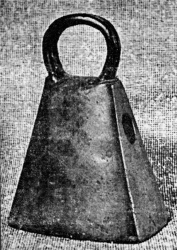
The Drumgath Bell' was found by a
local woman in 1764. It is now held in the Down
County Museum in Downpatrick.
The remains of a mound on the periphery of the burial
ground is still further evidence of a monastic settlement. The old
Drumgath burial ground, which was taken over some years ago by the then
Rural District Council, does not now reveal very much of its ancient
history. The inscriptions on the older crude grave stones are no longer
legible. Although it cannot be stated authoritatively, these headstones
are supposed to be the earliest ones in this part of the country on
which there were inscriptions. The burying ground, first mentioned in
1407, served St. John's Rathfriland and Drumgath until the new. Catholic
cemetery was opened some time after the building of a new church in
1833. The parish is now served by two other Catholic cemeteries.
RATHFRILAND TOWN
The name Rathfriland is generally said to mean "the
fort of Fraoileann". Fraoileann is presumed to be an early Irish
chieftain but nothing more is known about him. In earlier times it was
also referred to as "Oilcan Rath Fraoileann" i.e. the Island of the fort
of Fraoileann. The hill on which the town is situated was similar to an
island in the past as the land around was considerably wilder and more
marshy than it is today. Native Irish speakers referred to it as "Mullach
Rath Fraoileann" or, simply, "an mullach" - meaning `the summit'. The
strategic importance of the hill is obvious and it is likely to have
been fortified since ancient times. It was the seat of the Gaelic
Magennis clan of Iveagh and their castle was situated close to the
prominent modern water tower on the summit of the hill.

RATHFRILAND CASTLE
A stone castle is believed to have been erected in
the 15th. or 16th. century which would have replaced earlier wooden
structures. The original building is estimated to have been 30 feet by
50 feet and would also have had a stone perimeter wall. The stone was
quarried from the hill itself and created a steep precipice on the west
side which would have been useful in defending the site. The steepness
of the site can still be appreciated when approaching the town from the
Banbridge direction.
The Magennis clan were overlords of the territory of
Iveagh from 1136. Arthur Magennis, first Viscount Iveagh, was married to
Lady Sarah O'Neill the daughter of Hugh O'Neill, Earl of Tyrone, who led
the gaelic clans in the nine years' war against the English. He remained
on after the `Flight of the Earls' and the Plantation of Ulster. He died
in 1629 and was buried with his ancestors in Drumballyroney Churchyard
which is approximately a mile north of the town. (The church and
cemetery are in the Roman Catholic parish of Annaclone. They are now
part of the Bronte Homeland Museum). Lady Sarah lived after his death in
their castle at Narrow Water, Warrenpoint. His son, Hugh Magennis, was
the last of the family to hold Iveagh. His role in the 1641 rebellion
brought about their final downfall and loss of the family lands.
Following the defeat of the 1641 rebellion, the
castle was destroyed by Cromwell's General Ireton and the manor of
Rathfriland was granted to Alderman William Hawkins. His son, John
Hawkins finally pulled down most of the castle and built a new manor
house in the townland of Lessize below the town. No trace of this now
remains. John Hawkins married Mary Johnston of Gilford through whom the
family inherited the Gilford estate. He died in 1689 and was also buried
at Drumballyroney along with the Magennises. The manor passed down to
his great-granddaughter, Theodosia Hawkins Magill, who married Sir John
Meade, later Earl of Clanwilliam. She was an independent woman for her
time and managed these lands by herself leaving them, on her death, to
her second son. The family lived mostly in Norfolk but had a Georgian
Cottage at Burrenwood, near Castlewellan, which was built by Theodosia
Hawkins Magill.
All that remains standing today of Rathfriland Castle
is a small portion of the south gable wall. measuring 30 feet long by 25
feet wide. When it was finally taken down by John Hawkins, the stones
were said to have been used to build some of the oldest buildings of the
town. Among those which have survived is the old three-storey `Town Inn'
which still stands at the corner of The Square and Newry Street. The
cellar of this building was said to be the meeting place of the
notorious `Hellfire Club' in the 18th. Century.
The large town square was the site of a thriving
market for many years which like the town has now fallen into decline.
The Market House which stands in the centre was built in 1764 and stands
where there was formerly a village pond. From every street, radiating
out, there are panoramic views of the County Down countryside and the
mountains of Mourne.
On 14th. April 1834, the renowned gaelic scholar,
John O'Donovan, arrived in the town while travelling around the country
researching placenames for Ordnance Survey maps. He lodged in the Town
Inn for five nights. O'Donovan noted that "in the town there are upwards
of thirty public houses" and reported a high degree of drunkenness. He
was impressed by the beauty of the area and the friendliness of the
people, of whom he remarked "the inhabitants of this district of the
County of Down are a kind, warmhearted and tractable people and it is a
pity that the seeds of dissension should be sown among them by
ill-designing men and party newspapers".

ST. COLMAN'S CHURCH, BARNMEEN
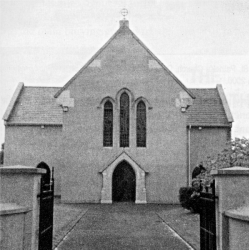
St. Colman's Church, Barnmeen
- the oldest Catholic church in use in the
diocese of Dromore.
Of the three Catholic churches in the parish, Saint
Colman's, Barnmeen, is the oldest and it is distinguished by being the
oldest Catholic church in use in the diocese of Dromore. It is located
close to Barnmeen Bridge, two miles west of Rathfriland, on the Newry
Road. The Church faces onto the old Newry Road which was superseded by
the present road in the early nineteenth century. It is a simple,
attractive country church in a fine unspoilt country setting.
The church was built in 1760 by Rev. Thomas Digenan
P.P., at a time when the Catholic Church in Ireland was only just
emerging from a period of intense persecution and Catholic
church-building was extremely rare indeed. Following the Reformation,
the first recorded Catholic priest in the area was Fr. Bryan Fegan who
was living in Tamary in the year 1691. He had been evicted from his farm
in Barnmeen. He was succeeded by a Fr. Mines and then by Fr. Digenan.
Fr. Digenan lived on a two-acre farm in Lurgancahone which he held on a
sub-lease from Con Boy Magennis. Magennis was a sub-landlord of that
townland and of Ballykeel, which he held under the Marquis of Downshire.
Patrick "Fegan of Barnmeen was another sub-landlord. He was known as
"the Laird" and was one of the few prosperous Catholics of the period.
His descendants still live in Barnmeen. Fr. Digenan was a native of
Drumgath Parish and was educated at the Irish College in Paris. He was
parish priest of Drumgath from 1745 to 1785 and was buried in the old
graveyard in Drumgath. The church was built with the assistance of the
Seneschal (similar to the modern-day magistrate) - one Captain Kerr of
Rathfriland.
The side-aisles were added in 1820 by Rev. Fergus
Rooney RR A free-standing iron bell tower was built alongside the church
by Rev. Canon Gallery P.P. in 1914. The sanctuary and high altar of 1905
was sensitively remodelled by Very. Rev. Canon Patrick McAnuff in the
1980s, to comply with the requirements of Vatican 11.
The church both inside and out fortunately retains
much of the austere, rustic charm of the vernacular Catholic and
Presbyterian churches of that era. The narrow, gothic lancet windows,
some of which still have plain diamond glazing, fill the interior with
light. Of particular note are the stained-glass windows behind the altar
by Clokey of Belfast. These depict the Crucifixion scene and were
erected by parishioners in 1880 as a memorial to the Barnmeen Martyrs.
The inscription (which was previously hidden from view by the old high
altar) reads "Sacred to the memory of those called the Barnmeen
Martyrs".
The first Barnmeen School formerly stood to the right
of the present entrance gate and is commemorated by a plaque. It was
burnt down by the Black and Tans during the troubles of 1921. The curate
at the time, Fr. McCartan, was arrested by the Black and Tans but
released the following day. He was referred to as "the bomber curate" by
an English Sunday Newspaper, for which he recovered �750 libel damages
in the High Court.

ST. MARY'S CHURCH, RATHFRILAND
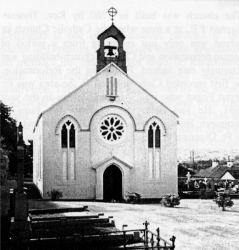
St. Mary's Church, Rathfriland
(1831). The striking rose window on the entrance
front was installed in 1936.
Saint Mary's, Rathfriland, was built in 1831, by Rev.
Laughlin Morgan P.P., at the bottom of Newry Street on the outskirts of
the town. It is similar to many of the Catholic churches which were
being built in the diocese during in the mid-19th. century.
As one enters, there is a fine stained-glass window
on the left, by the famous Harry Clarke studio, which depicts a crowned
virgin and child. The striking rose window on the entrance front was
erected in 1936. Many of the period features of the interior were
removed during renovations in 1980. This has unfortunately detracted
from the church's internal appearance.
To the north of the church can still be seen the
small ruined cottage, surrounded by trees, which was the Quaker
meeting-house in the town. It was built in 1780. For many years a
prominent Quaker family named Murphy lived in the town. William Penn is
reputed to have visited the town and lodged in the Town Inn.

ST. PATRICK'S CHURCH, DRUMGATH
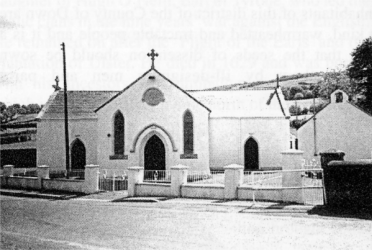
St. Patrick's Church,
Drumgath. The building was completely restored
in 2000.
Located approximately mid-way between Mayobridge and
Rathfriland, the small vernacular church of Saint Patrick's, Drumgath,
was erected in 1833 by Rev. Arthur Polin P.P. It was originally a long,
low building with two doors on one side and the altar at the centre of
the wall opposite. This design can often be seen in pre-Emancipation
Catholic and Presbyterian churches.
The original building contained the present transepts
and sanctuary. In 1865, the nave was added by Very Patrick McKey,
P.P., to give the present cruciform plan. The church's style is
traditional and typical of country churches built at that time. St.
Patrick's replaced a former Mass Station.
The building was completely restored by Rev. Gerard
Powell P.P., in 2000. The major renovation included the provision of a
new roof of natural slate, which is fully insulated and ventilated.
Because of rot and major worm infestation, all the timbers have been
replaced with steel and new timber. The walls were stripped back to the
original stone and replastered internally and externally. A new heating
system has been provided along with new seating, the renewal of the
floor structure, tiling and carpets. A new confessional was installed,
new porches were developed, rewiring was undertaken and amplification
with a loop system for the hearing-impaired was put in place. Outdoor
amplification is now provided for funerals and cemetery Masses. The
sanctuary includes new altar furniture - a baptismal font, ambo and
celebrant's chair. An old window has been reopened, leading into the
sacristy. Now known as the `Drumgath Jubilee 2000 Window,' it tells the
story of St. Patrick and the faith of the people of Drumgath. The
sacristy has been upgraded with new furniture and the building has been
fitted with fire and intruder alarms.
The former Drumgath Primary School which stood beside
the church was demolished in 2000 to make more room at the entrance to
the church. A gable wall was retained, which now serves as a bell tower
for the church.
On the east side of the Square in Rathfriland is
Saint John's Church of Ireland Parish Church, built in 1733. It has a
plain, rendered exterior with a squat tower to the front.
There are three Presbyterian churches in the town.
Rathfriland First Presbyterian Church stands at the bottom of Newry
Street. The congregation dates from 1662. Rathfriland Second
Presbyterian Church is situated further down, below the old school which
is now the Parish Centre, and was built in 1799. Rathfriland Third
Presbyterian Church is at the top of Newry Street and was built in 1836.
The Reformed Presbyterian Church is on Castle Lane and
was also erected in the 19th. century.
There is a Baptist Church, on the Loughbrickland Road,
which was built in 1982.


The historic Drumgath Cemetery.
Here rest the remains of the `Barnmeen Martyrs' and
their lawyer, Charles Christian.
This little-known, ancient site is located half a
mile or so beyond the present St. Patrick's Church in the direction of
Mayobridge. Local legend claims that Saint Patrick preached to followers
of his in the district. He ordered a spear to be cast off Tamary Hill,
which rises behind the graveyard, in order to choose the site for
building a church. From this, the name of the townland and the parish is
said to derive: "Druim an ghaith," meaning "the hill of the spear".
While this colourful legend is unlikely to have had any basis in fact,
the old graveyard was indeed the location of an early Christian church
or monastery. The site itself is circular in shape, like the ringforts
of the time. Although overgrown, the remains of some buildings can still
be identified. In the south- east corner a stone barrel-arch still
stands. The graveyard is covered in crude granite gravestones most of
which are now, sadly, illegible. Until Barnmeen graveyard was purchased
in the mid-19th. century, Old Drumgath was the main burying ground for
the parish.
In 1764, a local woman named Peggy McGivern found an
ancient hand-bell somewhere in the hedge near the graveyard. It is
similar in appearance to Saint Bronagh's Bell which can be seen in the
parish church in Rostrevor. The Drumgath Bell, as it is known, was
probably used in the church at the old graveyard. It is made of cast
bronze with an iron clapper and is eight inches high. The only
decorations are three grooves along the handle. There is a hole to one
side, presumably to improve the tone.
For many years it was used on the altar of Barnmeen
Church. The bell was given away in 1820 by the parish priest, Fr. Polin,
to Issac Glenny of Glenvale. Glenny was a famous local antiquarian whose
home is now the Carmelite convent. The Glenny collection was bequeathed
to the Belfast Museum and the Drumgath Bell is now on display in the
Down County Museum, in Downpatrick.
The story of the men known as the `Barnmeen Martyrs',
despite being almost two hundred years old, is still well remembered in
the locality. In 1820, twelve men were tried in Downpatrick Courthouse
for the murder of a Rathfriland man, Samuel Duncan. His death took place
on the night of 1st. November 1819 on the old road between Newry and
Rathfriland, not far from the present Drumgreenagh School. Of these
twelve, seven were convicted and sentenced to death. Five of them were
hanged outside the gates of the old jail in English Street, Downpatrick,
and two more had their death sentences commuted to penal servitude for
life.
In the early 19th. century sectarianism was rife in
the area. Wolfe Tone had visited Rathfriland in 1792 to meet with local
clergy in an attempt to calm local tensions following a sectarian
faction fight known as the "Battle" of Ballyknappogue. One person had
died and several others were injured in a fight between the Catholic
Defenders and Protestant Peep o'Day Boys. The conflict arose out of
Protestant objections to Catholics holding a burial at Drumballyroney
graveyard on a Sunday. The owner of the Town Inn refused to serve Wolfe
Tone. Tone satirically referred to Rathfriland as "that flourishing seat
of liberality and refinement" and expressed the opinion that "it cannot
be that the rabble of Rathfriland shall stop the growing liberty of
Ireland". It was in this environment that the martyrs' deaths occurred.
The victim, Samuel Duncan, a shoemaker from
Rathfriland, was on his way home from the All Saints' Day races at
Carnbane, near Newry. Local tradition has it that he was drunk and
cursing the Pope. It appears that he was struck over the head by
someone. He was taken home to Rathfriland, where he died later that
night.
Over the next few days, a large number of local men
were arrested by local militia and brought to the jail in Downpatrick.
They were tried at the assizes on 24th. March 1820. Local people
believed the charges to be so preposterous that an acquittal was widely
expected. The trial was presided over by Mr. Justice Bushe, a liberal
man who went on to become Lord Chief Justice of Ireland. The accused
were represented by Mr. Charles Russell Christian, a well-known
solicitor from Caddell's Lane in Rathfriland who was a passionate
advocate of Catholic Emancipation. The jury were all Protestant, as was
normal for the time. They convicted seven of the men, notwithstanding
the flimsy evidence against them.
A large number of Barnmeen people travelled to
Downpatrick to be present at the execution on Monday 27th. March 1820.
In those times hangings were held in public. The condemned men were
attended by Fr. McAleenan (later parish priest of Castlewellan) and are
said to have shown great composure in meeting their fate. They
reportedly asked the priest on the scaffold "Do we die as martyrs?", to
which he replied "You do, my children".
Their bodies were taken down and later secretly
recovered by their families, rather than be buried within the confines
of the jail as was required by law. They were laid overnight in the
Catholic Church of Ballykillbeg, between Downpatrick and Clough. On the
following day they were returned home in a cortege that was reputedly
over two miles long. The bodies were buried side by side in the old
graveyard in Drumgath. No memorial marks their resting place except for
a single stone over the grave of Hugh Toman. Incidentally, their lawyer,
Charles Christian, is also interred in the same graveyard in a prominent
railed enclosure with a tablet bearing the words "Christian's Place".
The two men due for transportation were brought to
Warrenpoint. There they boarded a prison ship bound for Liverpool and,
thereafter, Van Diemen's Land - modern day Tasmania.
The stained-glass windows behind the altar in
Barnmeen Church were erected by the people of the parish, in 1880, in
memory of the martyrs.

PRIESTS IN DRUMGATH PARISH
Drumgath Parish goes back to the year 1152 (the date
of the Synod of Kells) when parishes were first definitely drawn up and
arranged in Ireland. Before that time there were no parishes, as we know
them today. The people were ministered to by monks from the local
monastery.
| Vicars |
|
Milo Omistega (Myles McStay),
|
1407-1431 |
|
Michael O'Hennan, |
1431-1435 |
|
Eugene Magennis, |
1526
(after a long vacancy) |
|
John MacGennity, |
1530 |
|
Neil Mac Kay, |
1530 |
| |
|
| Parish Priests |
|
Bryan O'Fegan, |
1691 |
|
Father Mines, |
1731-1745 |
|
Thomas Digenan, |
1745-1785 |
|
Fergus Rooney, |
1785 -1822 |
|
Patrick Mac Evoy, |
1822-1831 |
|
Laughlin Morgan, |
1831 |
|
Arthur Polin, |
1831-1840 |
|
Thomas Brady, |
1840-1864 |
|
Patrick O'Neill, |
1864 |
|
Patrick Mac Key, |
1864-1872 |
|
Thomas Mac Givern, |
1872-1887 |
|
Thomas Gallery, |
1887-1932 |
|
James Fitzpatrick, |
1932-1949 |
|
James Mc Corry, |
1949-1972 |
|
James Mc Evoy, |
1972-1985 |
|
Patrick J. Mc Anuff, |
1985-1994 |
|
Aldan Hamill, |
1994-1998 |
|
Gerard Powell, |
1998-2001 |
|
James Poland, |
2001- |
| Curates |
| M.
McAlinden, |
1750 |
| Thomas Mac
Key, |
1814 |
| Patrick Mac
Evoy, |
1820-1822 |
| Thomas Mac
Givern, |
1832-1837 |
| William
Aiken, |
1837-1838 |
|
Michael Maginn, |
1838-1841 |
| Daniel
Mooney, |
1841-1843 |
| Bernard
Maginn, |
1843-1844 |
|
| John
Mooney, |
1844-1846 |
| Bernard
Troy, |
1846-1847 |
| John Mac
Donnell, |
1847-1850 |
| Michael
O'Loughlin, |
1850-1851 |
| Arthur
Finnegan, |
1851-1852 |
| Charles
O'Hare, |
1852-1863 |
| John
Gribben, |
1863-1864 |
| Felix Mac
Laughlin, |
1864 |
| Terence
Quinn, |
1864-1866 |
| Stephen Mac
Nulty, |
1866-1867 |
| Cornelius
Woods, |
1867-1871 |
| William
Bradley, |
1871-1879 |
| John
O'Hare, |
1879-1891 |
| Daniel
Grant, |
1891-1901 |
| William Mac
Ginn, |
1901-1905 |
| Patrick
Greenan, |
1905-1913 |
| Daniel
Toman, |
1913-1923 |
| Patrick Mac
Cartan, |
1919-1922 |
| Stephen Mc
Nulty, |
1922-1923 |
| John
Lennon, |
1923-1927 |
| James
Murney, |
1923-1932 |
| James
McCorry, |
1927-1934 |
| Michael
McCartan, |
1934-1941 |
| Daniel
Fegan, |
1941-1943 |
| James
McEvoy, |
1943-1945 |
| James
Murtagh, |
1945-1956 |
| James
Mooney, |
1956-1961 |
| Patrick
Rooney, |
1961-1967 |
| Gerard
McCrory, |
1967-1970 & 1970-1974 |
| Aldan
Hamill. |
1970-1971 |
| Desmond
Knowles, |
1974-1979 & 1980-1981 |
| James
Sheppard, |
1979 |
| Oliver
Mooney, |
1981-1988 |
| Kieran
McPartlan, |
1988-1992 |
| Patrick
Reidy C.S.Sp., |
1992-1997 |
| Martin
McAlinden, |
1997-2000 |
| Thomas
McConville, |
2000 - ad nunc. |
|

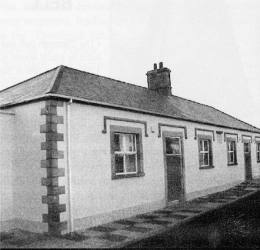
This former school building in
Rathfriland has been adapted, in recent years, for use
as a parish centre. The new St. Mary's Centre was opened
in 1996.
THE VENERABLE ARCHDEACON THOMAS
MOONEY
(FOUNDER CHAIRMAN OF THE DROMORE
DIOCESAN HISTORICAL SOCIETY)
Archdeacon Thomas Mooney was born in Lurgancahone,
educated at Maynooth and ordained in 1934. He spent the year following
his Ordination on a temporary mission in Down and Connor Diocese. Fr.
Mooney returned to his native diocese to become, successively, C.C.
Magheralin and C.C. Gargory, before becoming E.I. (1937-1950). In the
latter year he was appointed C.C. Seagoe. In 1959 he was appointed C.C.
Burren.
In 1963, Fr. Mooney was appointed Parish Priest of
Magheralin and became Parish Priest of Kilbroney in 1972. He was
appointed Archdeacon in January 1984 and retired in August 1987.
Archdeacon Mooney lives beside the church in Drumgath where he enjoys
his many interests. These include historical research, beekeeping and
gardening.
DRUMGATH JUBILEE 2000 WINDOW
This window was installed in St. Patrick's Church,
Drumgath, during the renovations which took place that year. It
celebrates aspects of the story of St. Patrick and of the Christian
heritage of Drumgath Parish.
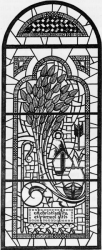
The symbols included in the window represent the
following:
Tree - The growth and spread of the
Christian faith through St. Patrick's teaching.
Arrow - The legend of the archer and St.Patrick.
The Drumgath Bell - Ancient bell found by a
parishioner in the nineteenth century.
Bishop's mitre - St.Patrick
Ship & wave - St. Patrick's journey to Ireland.
Shepherd's staff- St. Patrick's early years on Slemish.
Four shamrocks - The four provinces.
Three sets of three squares -The Trinity.
Trefoil shape of border - The Trinity.
The dove - The Holy Spirit.
 |